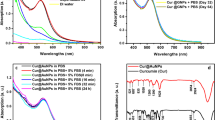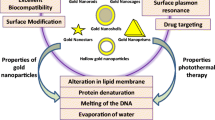Abstract
Heating response of gold nanoclusters of two different sizes (2 and 3 nm) under radio frequency electric field has been reported here for the first time. Experiments were performed on colloidal solution of nanoparticles and their in vitro hyperthermia effect was investigated on pancreatic cancer cells (MIA Paca-2). Gold nanoclusters at concentrations up to 200 ppm were found non-toxic, based on the results of cytotoxicity assay using tetrazolium dye MTT and at concentrations up to 50 ppm exhibited very low hemolytic activity. Gold nanoclusters of two sizes resulted in up to 50 °C temperature rise when in radio frequency electric field of 100 W power. Smaller clusters were found more efficient for heat generation and thus were applied in cell studies. Gold nanoclusters (at 5–200 ppm concentrations) under radio frequency electric field (100 W, 2 and 4 min of exposure duration) exhibited successful eradication of pancreatic cancerous cells.




Similar content being viewed by others
References
Häkkinen H et al (2003) Structural, electronic, and impurity-doping effects in nanoscale chemistry: supported gold nanoclusters. Angew Chem Int Ed 42(11):1297–1300
Jin R (2010) Quantum sized, thiolate-protected gold nanoclusters. Nanoscale 2(3):343–362
Crespo P et al (2004) Permanent magnetism, magnetic anisotropy, and hysteresis of thiol-capped gold nanoparticles. Phys Rev Lett 93(8):087204
Emami T et al (2015) Comparison of gold nanoparticle conjugated secondary antibody with non-gold secondary antibody in an ELISA kit model. Monoclonal antibodies in immunodiagnosis and immunotherapy 34(5):366–370
Amini SM et al Effect of gold nanoparticles on photodynamic efficiency of 5-aminolevolenic acid photosensitiser in epidermal carcinoma cell line: an in vitro study. Nanobiotechnology, IET 7(4):151–156
Murphy CJ et al (2008) Gold nanoparticles in biology: beyond toxicity to cellular imaging. Acc Chem Res 41(12):1721–1730
Melamed JR, Edelstein RS, Day ES (2015) Elucidating the fundamental mechanisms of cell death triggered by photothermal therapy. ACS Nano 9(1):6–11
Collins CB et al (2014) Radiofrequency heating pathways for gold nanoparticles. Nanoscale 6(15):8459–8472
Hanson GW, Monreal R, Apell SP (2011) Electromagnetic absorption mechanisms in metal nanospheres: bulk and surface effects in radiofrequency-terahertz heating of nanoparticles. J Appl Phys 109(12):124306
Glazer ES, Curley SA (2010) Radiofrequency field-induced thermal cytotoxicity in cancer cells treated with fluorescent nanoparticles. Cancer 116(13):3285–3293
Gannon CJ et al (2008) Intracellular gold nanoparticles enhance non-invasive radiofrequency thermal destruction of human gastrointestinal cancer cells. J Nanobiotechnology 6(2):10.1186
Curley SA et al (2008) Noninvasive radiofrequency field-induced hyperthermic cytotoxicity in human cancer cells using cetuximab-targeted gold nanoparticles. J Exp Ther Oncol 7(4):313–326
Corr SJ et al (2012) Citrate-capped gold nanoparticle electrophoretic heat production in response to a time-varying radiofrequency electric-field. J Phys Chem C, Nanomater Interfaces 116(45):24380–24389
Li D et al (2012) The effect of sample holder geometry on electromagnetic heating of nanoparticle and NaCl solutions at 13. 56 MHz. IEEE Trans Biomed Eng 59(12):3468–3474
McCoy RS et al (2013) Superatom paramagnetism enables gold nanocluster heating in applied radiofrequency fields. ACS Nano 7(3):2610–2616
Sassaroli E, Li K, O’Neill B (2012) Radio frequency absorption in gold nanoparticle suspensions: a phenomenological study. J Phys D Appl Phys 45(7):075303
Corr, S.J., et al., Citrate-capped gold nanoparticle electrophoretic heat production in response to a time-varying radio-frequency electric field. J Phys Chem C, 2012. 116(45): p. 24380–24389.
Postnikov, A. and K. Moldosanov (2015) Phonon-assisted radiofrequency absorption by gold nanoparticles resulting in hyperthermia. arXiv preprint arXiv:1508.00735.
Mathew A, Pradeep T (2014) Noble metal clusters: applications in energy, environment, and biology. Part Part Syst Charact 31(10):1017–1053
Goodman CM et al (2004) Toxicity of gold nanoparticles functionalized with cationic and anionic side chains. Bioconjug Chem 15(4):897–900
Xu C, Tung GA, Sun S (2008) Size and concentration effect of gold nanoparticles on X-ray attenuation as measured on computed tomography. Chem Mater 20(13):4167–4169
Chen S, Kimura K (1999) Synthesis and characterization of carboxylate-modified gold nanoparticle powders dispersible in water. Langmuir 15(4):1075–1082
Corr SJ et al (2013) Protocols for assessing radiofrequency interactions with gold nanoparticles and biological systems for non-invasive hyperthermia cancer therapy. JoVE (Journal of Visualized Experiments) 78:e50480–e50480
Dobrovolskaia MA et al (2008) Method for analysis of nanoparticle hemolytic properties in vitro. Nano Lett 8(8):2180–2187
Ramakrishna G et al (2008) Quantum-sized gold clusters as efficient two-photon absorbers. J Am Chem Soc 130(15):5032–5033
Haiss W et al (2007) Determination of size and concentration of gold nanoparticles from UV-vis spectra. Anal Chem 79(11):4215–4221
Hanaor D et al (2012) The effects of carboxylic acids on the aqueous dispersion and electrophoretic deposition of ZrO 2. J Eur Ceram Soc 32(1):235–244
Sassaroli E, Li KCP, O’Neill BE Radio frequency absorption in gold nanoparticle suspensions: a phenomenological study. J Phys D Appl Phys 45(7):075303
Moran CH et al (2009) Size-dependent joule heating of gold nanoparticles using capacitively coupled radiofrequency fields. Nano Res 2(5):400–405
Sharifi S et al (2012) Toxicity of nanomaterials. Chem Soc Rev 41(6):2323–2343
Marquis BJ et al (2009) Analytical methods to assess nanoparticle toxicity. Analyst 134(3):425–439
Khlebtsov N, Dykman L (2011) Biodistribution and toxicity of engineered gold nanoparticles: a review of in vitro and in vivo studies. Chem Soc Rev 40(3):1647–1671
Khullar P et al (2012) Bovine serum albumin bioconjugated gold nanoparticles: synthesis, hemolysis, and cytotoxicity toward cancer cell lines. J Phys Chem C 116(15):8834–8843
Kruse DE et al (2011) A radio-frequency coupling network for heating of citrate-coated gold nanoparticles for cancer therapy: design and analysis. IEEE Trans Biomed Eng 58(7):2002–2012
Raoof M et al (2014) Gold nanoparticles and radiofrequency in experimental models for hepatocellular carcinoma. Nanomedicine: Nanotechnol, Biol Med 10(6):1121–1130
Glazer ES et al (2010) Noninvasive radiofrequency field destruction of pancreatic adenocarcinoma xenografts treated with targeted gold nanoparticles. Clin Cancer Res 16(23):5712–5721
Curley SA et al (2014) The effects of non-invasive radiofrequency treatment and hyperthermia on malignant and nonmalignant cells. Int J Environ Res Public Health 11(9):9142–9153
Acknowledgements
The authors are thankful to Mr. M. Rahvar for his help in hemolysis studies.
Author information
Authors and Affiliations
Corresponding author
Ethics declarations
Funding
This study was funded by Tehran University of Medical Sciences (TUMS) (grant number 93-01-87-25211).
Conflict of interest
The authors declare that they have no conflict of interest.
Ethical approval
This article does not contain any studies with human participants or animals performed by any of the authors.
Electronic supplementary material
ESM 1
(DOCX 42.4 kb)
Rights and permissions
About this article
Cite this article
Amini, S.M., Kharrazi, S. & Jaafari, M.R. Radio frequency hyperthermia of cancerous cells with gold nanoclusters: an in vitro investigation. Gold Bull 50, 43–50 (2017). https://doi.org/10.1007/s13404-016-0192-6
Received:
Accepted:
Published:
Issue Date:
DOI: https://doi.org/10.1007/s13404-016-0192-6




